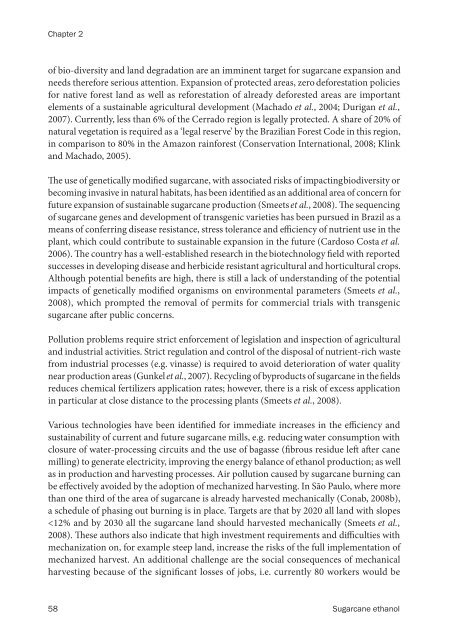Sugarcane ethanol: Contributions to climate change - BAFF
Sugarcane ethanol: Contributions to climate change - BAFF
Sugarcane ethanol: Contributions to climate change - BAFF
You also want an ePaper? Increase the reach of your titles
YUMPU automatically turns print PDFs into web optimized ePapers that Google loves.
Chapter 2<br />
of bio-diversity and land degradation are an imminent target for sugarcane expansion and<br />
needs therefore serious attention. Expansion of protected areas, zero deforestation policies<br />
for native forest land as well as reforestation of already deforested areas are important<br />
elements of a sustainable agricultural development (Machado et al., 2004; Durigan et al.,<br />
2007). Currently, less than 6% of the Cerrado region is legally protected. A share of 20% of<br />
natural vegetation is required as a ‘legal reserve’ by the Brazilian Forest Code in this region,<br />
in comparison <strong>to</strong> 80% in the Amazon rainforest (Conservation International, 2008; Klink<br />
and Machado, 2005).<br />
�e use of genetically modi�ed sugarcane, with associated risks of impacting biodiversity or<br />
becoming invasive in natural habitats, has been identi�ed as an additional area of concern for<br />
future expansion of sustainable sugarcane production (Smeets et al., 2008). �e sequencing<br />
of sugarcane genes and development of transgenic varieties has been pursued in Brazil as a<br />
means of conferring disease resistance, stress <strong>to</strong>lerance and e�ciency of nutrient use in the<br />
plant, which could contribute <strong>to</strong> sustainable expansion in the future (Cardoso Costa et al.<br />
2006). �e country has a well-established research in the biotechnology �eld with reported<br />
successes in developing disease and herbicide resistant agricultural and horticultural crops.<br />
Although potential bene�ts are high, there is still a lack of understanding of the potential<br />
impacts of genetically modi�ed organisms on environmental parameters (Smeets et al.,<br />
2008), which prompted the removal of permits for commercial trials with transgenic<br />
sugarcane a�er public concerns.<br />
Pollution problems require strict enforcement of legislation and inspection of agricultural<br />
and industrial activities. Strict regulation and control of the disposal of nutrient-rich waste<br />
from industrial processes (e.g. vinasse) is required <strong>to</strong> avoid deterioration of water quality<br />
near production areas (Gunkel et al., 2007). Recycling of byproducts of sugarcane in the �elds<br />
reduces chemical fertilizers application rates; however, there is a risk of excess application<br />
in particular at close distance <strong>to</strong> the processing plants (Smeets et al., 2008).<br />
Various technologies have been identi�ed for immediate increases in the e�ciency and<br />
sustainability of current and future sugarcane mills, e.g. reducing water consumption with<br />
closure of water-processing circuits and the use of bagasse (�brous residue le� a�er cane<br />
milling) <strong>to</strong> generate electricity, improving the energy balance of <strong>ethanol</strong> production; as well<br />
as in production and harvesting processes. Air pollution caused by sugarcane burning can<br />
be e�ectively avoided by the adoption of mechanized harvesting. In São Paulo, where more<br />
than one third of the area of sugarcane is already harvested mechanically (Conab, 2008b),<br />
a schedule of phasing out burning is in place. Targets are that by 2020 all land with slopes<br />












